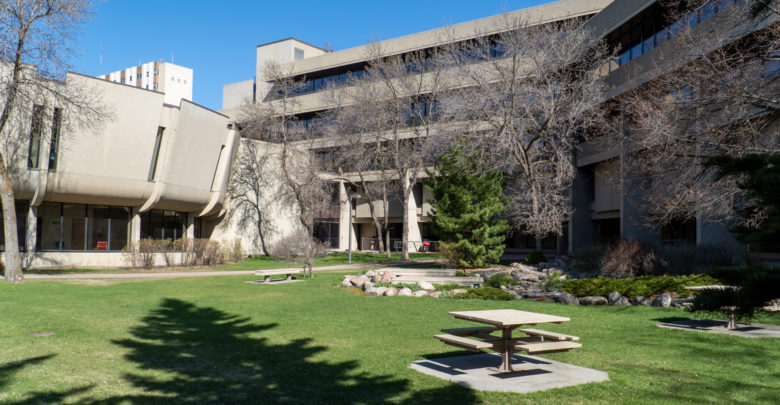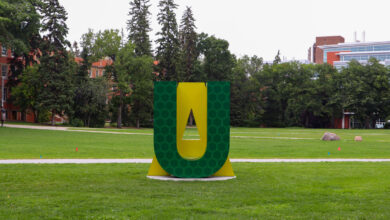 Martin Bendico
Martin BendicoWhile I knew it was an open secret that the university does not value the arts as highly as other disciplines, I did not know this could be manifested in the environment.
On the first day of school, I arrived at my last class of the day. Unfortunately, the class was located in the Humanities Centre. For those who have never had the misfortune of entering the Humanities Centre, it is a slowly disintegrating sauna — architecturally no different than a particularly unappealing correctional facility. The main hall is a mess of dirty floors and carpets, well-worn furniture, and a distinct ambient temperature that seems well above any other building on campus.
The classrooms in Humanities, which I often have to use as an arts student, are defined by decades-old desks and chairs, windows that do not open, and clocks that do not work. These classrooms, just like the rest of the university, were designated to be kept in a state of “moderate dinginess.”
This designation is part of a larger scale of cleanliness designed by the Association of Higher Education Facilities Officers (APPA), an organization that advises schools and post-secondaries on various managerial issues. Moderate dinginess correlates to level four out of five on APPA’s “Five Levels of Clean.”
Level three, which would be a higher standard of cleanliness, is known as “casual inattention.” Meanwhile, the lowest level, which I imagine is only reserved for the basement of the Tory building, is known as “unkempt neglect.”
According to APPA, any space which is classed as moderately dingy must have floors that are swept or vacuumed clean, but are dull and stained. Surfaces are permitted to have conspicuous amounts of dust, dirt, marks, smudges, and fingerprints. Lighting fixtures are permitted to be dirty, and up to five per cent are allowed to be burned out. Finally, and perhaps most shamefully, all trash cans can have old garbage and “are permitted to exude a sour odour.”
Now, this state of cleanliness is common for arts students. Anyone who has been through Humanities or Tory can attest. However, this is not common for every member of the student body.
For instance, as you pass through the Centennial Centre for Interdisciplinary Sciences (CCIS), it is hard to believe that the building is kept at the same level of cleanliness as Humanities. However, the university’s Cleaning Service Standards state that moderate dinginess is the “average” level of cleanliness on campus. Meaning by definition, some areas are more clean, and others less so.
The more immaculate of APPA’s five levels of clean dictate that the floors must shine in the rays of perfectly working light fixtures. These levels certainly seem more akin to the state of CCIS, amongst other non-arts buildings such as Donadeo. Perhaps, these more modern buildings hide dirt and grime better than the more decrepit arts buildings. Or maybe more attention is placed on their upkeep.
A provided comment from the university explained how the facilities and operations team manages cleaning campus.
“Our cleaning staff and contractors follow a set of approved industry standards. All buildings on our five campuses are on similar cleaning schedules with a goal of providing safe and welcoming spaces to our community.”
The university asserts that all buildings on campus are cleaned to the same levels and standards.
“Each building undergoes cleaning inspections every two months, with spot checks between scheduled inspections to provide an overall assessment throughout the year. Data analysis helps optimize our service delivery model while ensuring service levels are achieved and consistently maintained.”
Even with data analysis and cleaning inspections, it feels like something is amiss. Even if those service levels are met and maintained, that doesn’t change the fact that the current standard is low.
Arts students pay the same tuition as students of other disciplines. What is it about the arts which merits its buildings to be left in relative disregard?
Under the University’s Capital Plan for “space optimization,” the Humanities building will not be used as a teaching space for university students in the near future. The mounting costs of years worth of deferred maintenance means that the leasing of the Humanities Centres will be cheaper than its restoration.
For any other faculty, the proposed leasing of its central building, and the subsequent dispersal of its courses and offices to other far flung buildings, would be a cause of outrage. This dispersal would mean students in the arts and humanities would receive a less organized learning experience. As a result, us arts students are left in the lurch.
Attempting to persuade the university that the arts are as valid as science and engineering is futile. But, the fact is that U of A students, whether they’re in the arts or sciences, are paying thousands of dollars for a world-class, top-five-in-Canada-level education. For now, arts students can expect to learn in moderately dingy rooms, with sour smelling trash, and flickering light bulbs.




